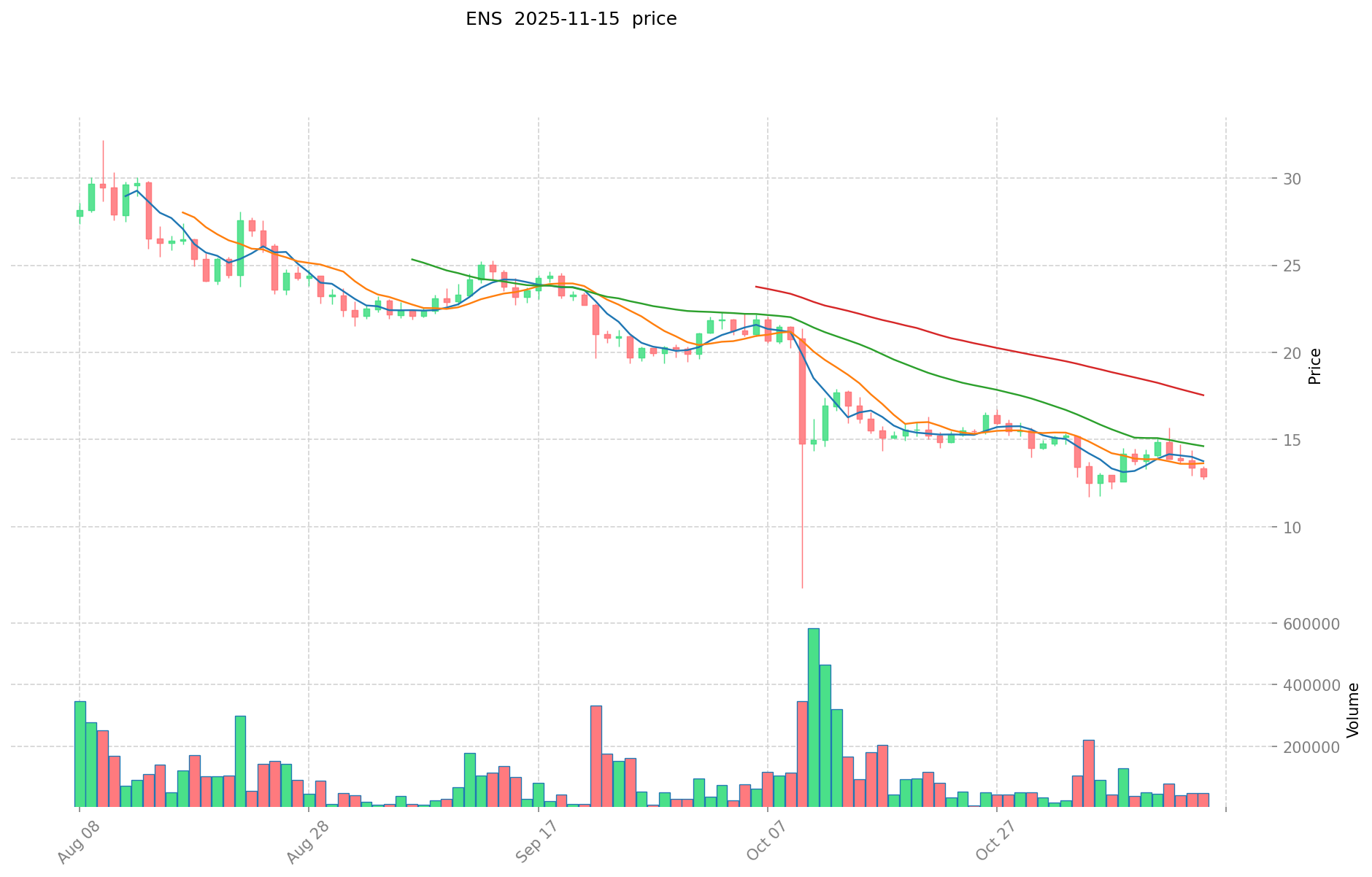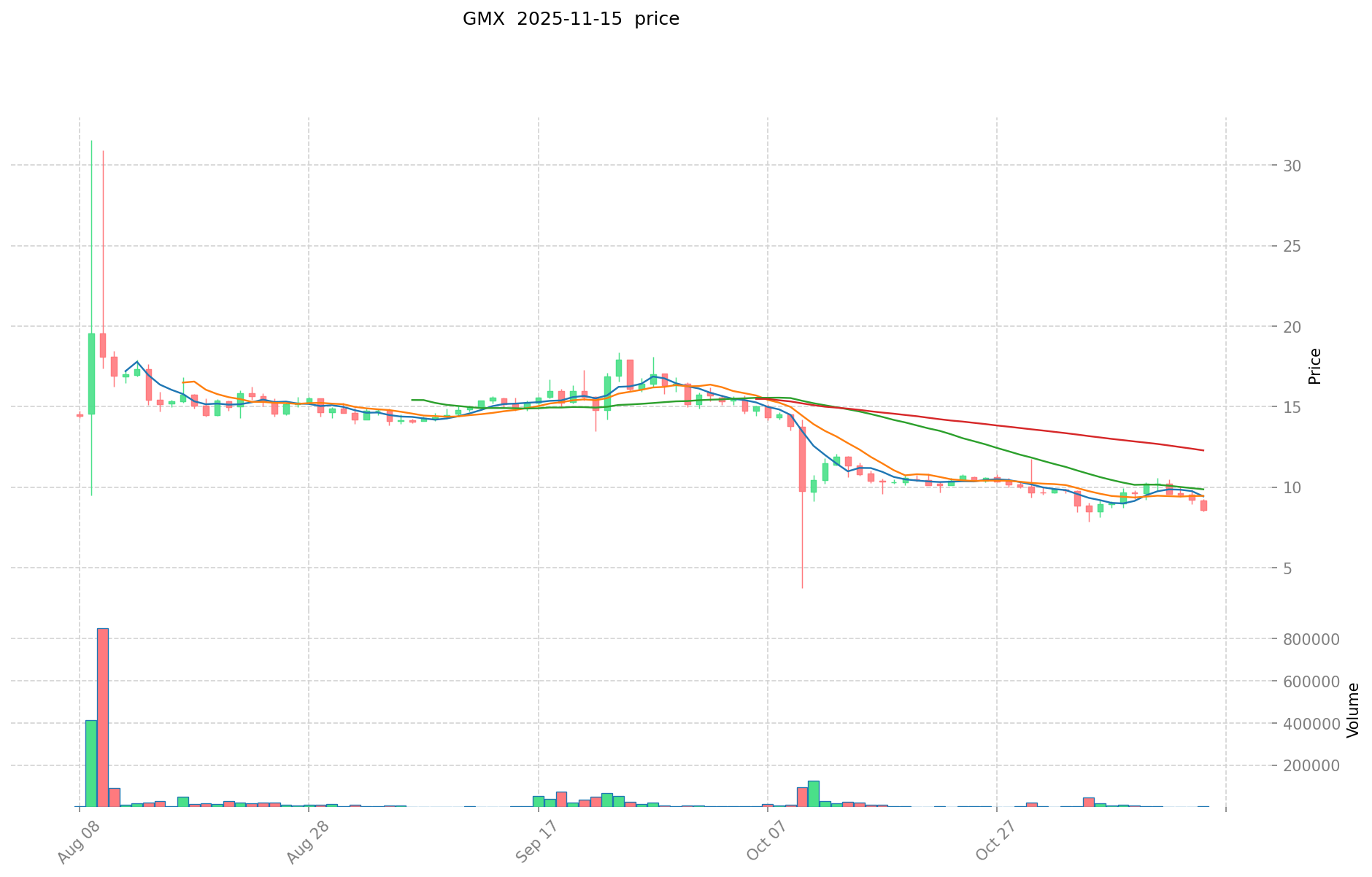ENS vs GMX: Which Decentralized Domain Name System Will Dominate Web3?
Introduction: Investment Comparison of ENS vs GMX
In the cryptocurrency market, ENS vs GMX comparison has always been a topic that investors cannot avoid. The two not only have significant differences in market cap ranking, application scenarios, and price performance, but also represent different cryptocurrency asset positioning.
ENS (ENS): Since its launch, it has gained market recognition for its role as a distributed, open, and extensible naming system based on the Ethereum blockchain.
GMX (GMX): Since its inception, it has been hailed as a decentralized perpetual exchange, with its token serving as both a utility and governance token.
This article will comprehensively analyze the investment value comparison between ENS and GMX, focusing on historical price trends, supply mechanisms, institutional adoption, technological ecosystems, and future predictions, and attempt to answer the question that investors are most concerned about:
"Which is the better buy right now?"
I. Price History Comparison and Current Market Status
ENS and GMX Historical Price Trends
- 2021: ENS reached its all-time high of $83.4 on November 11, 2021.
- 2023: GMX hit its all-time high of $91.07 on April 18, 2023.
- Comparative analysis: ENS has fallen from its ATH of $83.4 to a current price of $13.304, while GMX has dropped from its peak of $91.07 to $8.829.
Current Market Situation (2025-11-15)
- ENS current price: $13.304
- GMX current price: $8.829
- 24-hour trading volume: ENS $481,851.42521 vs GMX $27,137.432544
- Market Sentiment Index (Fear & Greed Index): 10 (Extreme Fear)
Click to view real-time prices:
- View ENS current price Market Price
- View GMX current price Market Price
II. Market Capitalization and Supply Analysis
ENS (Ethereum Name Service)
- Market Cap: $503,188,012.03
- Circulating Supply: 37,822,309.98 ENS
- Total Supply: 100,000,000 ENS
- Max Supply: 100,000,000 ENS
GMX
- Market Cap: $91,366,106.03
- Circulating Supply: 10,348,409.34 GMX
- Total Supply: 10,348,409.34 GMX
- Max Supply: 13,250,000 GMX
Comparative Analysis
- ENS has a significantly larger market cap, about 5.5 times that of GMX.
- ENS has a higher circulating supply and total supply compared to GMX.
- ENS has reached 37.82% of its max supply, while GMX has reached 78.10% of its max supply.
III. Project Overview and Use Cases
ENS (Ethereum Name Service)
- A distributed, open, and extensible naming system based on the Ethereum blockchain.
- Maps human-readable names (e.g., "alice.eth") to machine-readable identifiers like Ethereum addresses, other cryptocurrency addresses, content hashes, and metadata.
- ENS token is used for governance and voting on treasury grants.
GMX
- A decentralized perpetual exchange.
- GMX token serves as a utility and governance token.
- Token holders receive 30% of the platform's generated fees.
IV. Recent Developments and Future Outlook
ENS (Ethereum Name Service)
- No specific recent developments mentioned in the provided data.
- Future growth potential may be tied to the increasing adoption of Ethereum and the need for user-friendly naming systems in the blockchain space.
GMX
- No specific recent developments mentioned in the provided data.
- Future prospects may depend on the growth of decentralized derivatives trading and the platform's ability to compete with other DEXs.
V. Investment Considerations
- Both tokens have experienced significant price declines from their all-time highs.
- The current extreme fear market sentiment suggests a potentially oversold market, but also indicates high risk.
- ENS has a larger market presence and liquidity compared to GMX.
- Investors should consider the different use cases and ecosystems of each project when making investment decisions.
Disclaimer: This report is for informational purposes only and should not be considered as financial advice. Always conduct your own research before making any investment decisions.


II. Core Factors Affecting the Investment Value of ENS vs GMX
Supply Mechanism Comparison (Tokenomics)
- ENS: Fixed maximum supply of 100 million tokens, with 25% allocated to the DAO treasury and 25% to the airdrop
- GMX: Deflationary model with 70% of platform fees used for token buybacks and burns
- 📌 Historical pattern: ENS follows more gradual price movements tied to domain registrations, while GMX shows stronger correlation with trading volume and fee generation on its platform
Institutional Adoption and Market Applications
- Institutional holdings: GMX has attracted more trading firms and market makers due to its capital efficiency and trading utility
- Enterprise adoption: ENS has broader web3 identity applications across major platforms, while GMX serves primarily as a trading platform with specific DeFi use cases
- Regulatory attitudes: ENS faces less regulatory scrutiny as a naming service, while GMX's leveraged trading functionality attracts more regulatory attention
Technical Development and Ecosystem Building
- ENS technical upgrades: Introduction of Ethereum L2 support, enhanced privacy features, and expanded multi-chain functionality
- GMX technical development: Launch of GMX V2 with improved capital efficiency, multi-asset trading, and real-yield generation mechanics
- Ecosystem comparison: ENS serves as foundational infrastructure across the entire web3 space, while GMX has built a more focused trading and lending ecosystem
Macroeconomic Factors and Market Cycles
- Performance in inflationary environments: GMX demonstrates stronger inflation resistance through its fee-sharing model during high market volatility
- Macroeconomic monetary policy: Interest rate hikes typically reduce speculative trading volumes affecting GMX more directly than ENS
- Geopolitical factors: Cross-border regulatory changes affect GMX's accessible markets more significantly than ENS's utility services
III. 2025-2030 Price Prediction: ENS vs GMX
Short-term Prediction (2025)
- ENS: Conservative $11.03 - $13.29 | Optimistic $13.29 - $17.01
- GMX: Conservative $8.48 - $8.83 | Optimistic $8.83 - $9.36
Mid-term Prediction (2027)
- ENS may enter a growth phase, with prices expected in the range of $16.26 - $22.93
- GMX may enter a consolidation phase, with prices expected in the range of $8.87 - $14.17
- Key drivers: Institutional capital inflow, ETF, ecosystem development
Long-term Prediction (2030)
- ENS: Base scenario $25.08 - $27.87 | Optimistic scenario $27.87 - $33.16
- GMX: Base scenario $8.88 - $17.07 | Optimistic scenario $17.07 - $24.24
Disclaimer: The above predictions are based on historical data and current market trends. Cryptocurrency markets are highly volatile and subject to change. This information should not be considered as financial advice. Always conduct your own research before making investment decisions.
ENS:
| 年份 | 预测最高价 | 预测平均价格 | 预测最低价 | 涨跌幅 |
|---|---|---|---|---|
| 2025 | 17.00608 | 13.286 | 11.02738 | 0 |
| 2026 | 19.0840104 | 15.14604 | 13.0255944 | 13 |
| 2027 | 22.934133768 | 17.1150252 | 16.25927394 | 28 |
| 2028 | 26.23219912404 | 20.024579484 | 18.42261312528 | 50 |
| 2029 | 32.6110289186682 | 23.12838930402 | 19.4278470153768 | 73 |
| 2030 | 33.164953842499479 | 27.8697091113441 | 25.08273820020969 | 109 |
GMX:
| 年份 | 预测最高价 | 预测平均价格 | 预测最低价 | 涨跌幅 |
|---|---|---|---|---|
| 2025 | 9.36086 | 8.831 | 8.47776 | 0 |
| 2026 | 10.1874416 | 9.09593 | 6.0942731 | 3 |
| 2027 | 14.173278126 | 9.6416858 | 8.870350936 | 9 |
| 2028 | 16.90862438746 | 11.907481963 | 6.54911507965 | 34 |
| 2029 | 19.7390328500651 | 14.40805317523 | 7.3481071193673 | 63 |
| 2030 | 24.244431077959521 | 17.07354301264755 | 8.878242366576726 | 93 |
IV. Investment Strategy Comparison: ENS vs GMX
Long-term vs Short-term Investment Strategies
- ENS: Suitable for investors focused on web3 infrastructure and long-term ecosystem growth
- GMX: Suitable for traders seeking exposure to decentralized derivatives and fee-sharing models
Risk Management and Asset Allocation
- Conservative investors: ENS: 70% vs GMX: 30%
- Aggressive investors: ENS: 40% vs GMX: 60%
- Hedging tools: Stablecoin allocation, options, cross-token portfolios
V. Potential Risk Comparison
Market Risks
- ENS: Dependency on Ethereum ecosystem growth and adoption
- GMX: Vulnerability to market volatility and trading volume fluctuations
Technical Risks
- ENS: Scalability, network stability
- GMX: Smart contract vulnerabilities, liquidity risks
Regulatory Risks
- Global regulatory policies may have different impacts on both tokens, with GMX potentially facing more scrutiny due to its trading functionality
VI. Conclusion: Which Is the Better Buy?
📌 Investment Value Summary:
- ENS advantages: Broader ecosystem application, larger market cap, foundational web3 infrastructure
- GMX advantages: Fee-sharing model, potential for higher returns in volatile markets, deflationary tokenomics
✅ Investment Advice:
- Novice investors: Consider a higher allocation to ENS due to its more established market presence
- Experienced investors: Balanced portfolio with both ENS and GMX, adjusting based on market conditions
- Institutional investors: Strategic allocation to both, with ENS for long-term web3 exposure and GMX for DeFi trading opportunities
⚠️ Risk Warning: The cryptocurrency market is highly volatile. This article does not constitute investment advice. None
VII. FAQ
Q1: What are the main differences between ENS and GMX? A: ENS is a distributed naming system on Ethereum, while GMX is a decentralized perpetual exchange. ENS focuses on mapping human-readable names to blockchain addresses, while GMX provides a platform for trading and earning fees.
Q2: Which token has a larger market cap? A: ENS has a significantly larger market capitalization, approximately 5.5 times that of GMX.
Q3: How do the supply mechanisms of ENS and GMX differ? A: ENS has a fixed maximum supply of 100 million tokens, while GMX employs a deflationary model with token buybacks and burns using 70% of platform fees.
Q4: Which token is considered more suitable for long-term investment? A: ENS is generally considered more suitable for long-term investment due to its broader ecosystem application and role as foundational web3 infrastructure.
Q5: How do institutional investors view ENS and GMX? A: Institutional investors tend to view ENS as a long-term play on web3 infrastructure, while GMX is seen as an opportunity in the DeFi trading space.
Q6: What are the main risks associated with each token? A: ENS risks include dependency on Ethereum ecosystem growth and adoption, while GMX faces risks related to market volatility and potential regulatory scrutiny due to its trading functionality.
Q7: How might macroeconomic factors affect ENS and GMX differently? A: Interest rate hikes typically reduce speculative trading volumes, affecting GMX more directly than ENS. GMX also demonstrates stronger inflation resistance through its fee-sharing model during high market volatility.
Share
Content